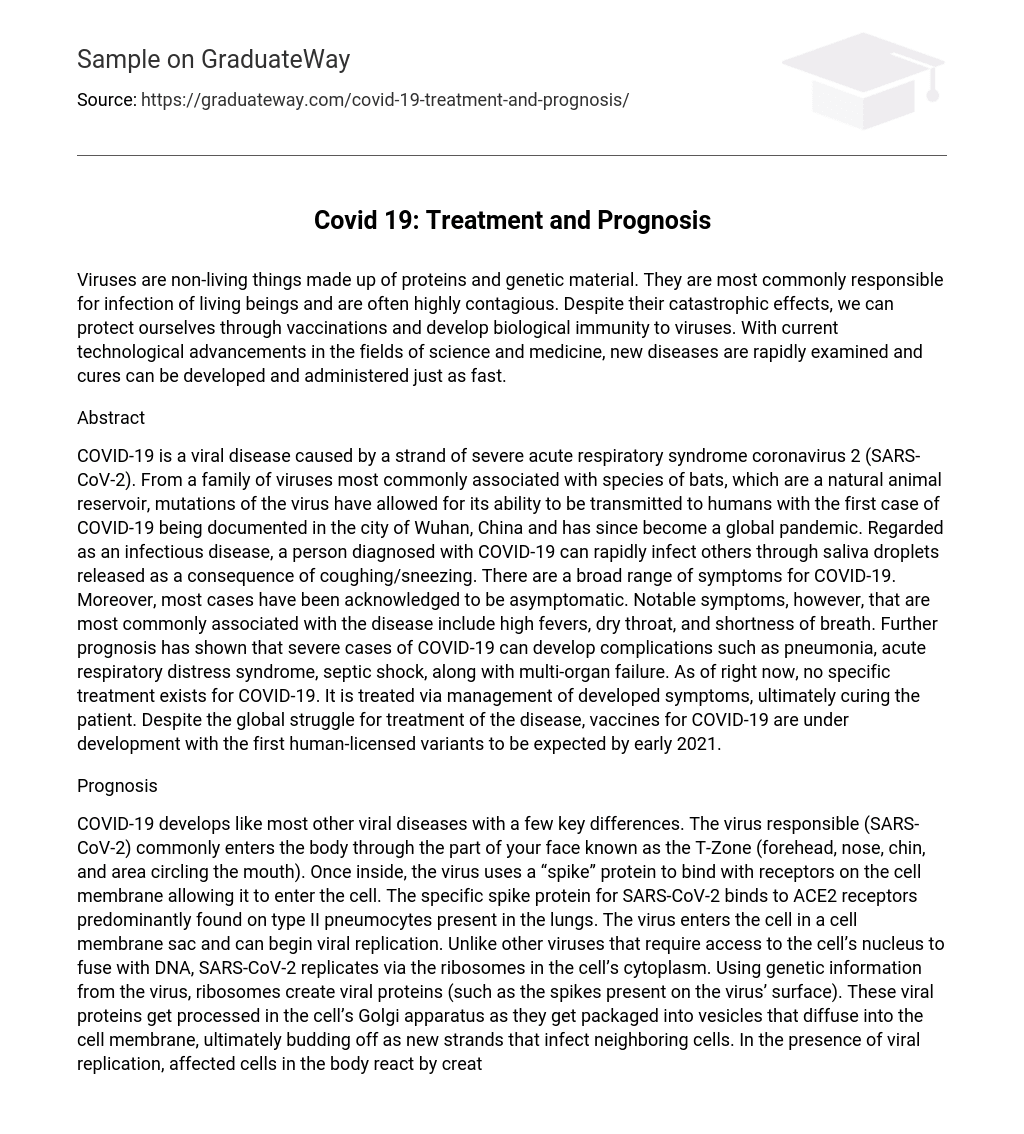Viruses are non-living things made up of proteins and genetic material. They are most commonly responsible for infection of living beings and are often highly contagious. Despite their catastrophic effects, we can protect ourselves through vaccinations and develop biological immunity to viruses. With current technological advancements in the fields of science and medicine, new diseases are rapidly examined and cures can be developed and administered just as fast.
Abstract
COVID-19 is a viral disease caused by a strand of severe acute respiratory syndrome coronavirus 2 (SARS-CoV-2). From a family of viruses most commonly associated with species of bats, which are a natural animal reservoir, mutations of the virus have allowed for its ability to be transmitted to humans with the first case of COVID-19 being documented in the city of Wuhan, China and has since become a global pandemic. Regarded as an infectious disease, a person diagnosed with COVID-19 can rapidly infect others through saliva droplets released as a consequence of coughing/sneezing. There are a broad range of symptoms for COVID-19. Moreover, most cases have been acknowledged to be asymptomatic. Notable symptoms, however, that are most commonly associated with the disease include high fevers, dry throat, and shortness of breath. Further prognosis has shown that severe cases of COVID-19 can develop complications such as pneumonia, acute respiratory distress syndrome, septic shock, along with multi-organ failure. As of right now, no specific treatment exists for COVID-19. It is treated via management of developed symptoms, ultimately curing the patient. Despite the global struggle for treatment of the disease, vaccines for COVID-19 are under development with the first human-licensed variants to be expected by early 2021.
Prognosis
COVID-19 develops like most other viral diseases with a few key differences. The virus responsible (SARS-CoV-2) commonly enters the body through the part of your face known as the T-Zone (forehead, nose, chin, and area circling the mouth). Once inside, the virus uses a “spike” protein to bind with receptors on the cell membrane allowing it to enter the cell. The specific spike protein for SARS-CoV-2 binds to ACE2 receptors predominantly found on type II pneumocytes present in the lungs. The virus enters the cell in a cell membrane sac and can begin viral replication. Unlike other viruses that require access to the cell’s nucleus to fuse with DNA, SARS-CoV-2 replicates via the ribosomes in the cell’s cytoplasm. Using genetic information from the virus, ribosomes create viral proteins (such as the spikes present on the virus’ surface). These viral proteins get processed in the cell’s Golgi apparatus as they get packaged into vesicles that diffuse into the cell membrane, ultimately budding off as new strands that infect neighboring cells. In the presence of viral replication, affected cells in the body react by creating an internal inflammatory response that leads to pyroptosis (cell death via inflammation). Macrophages are responsible for such an immune response as they secrete cytokines into the cellular matrix that trigger pyroptosis. As an affected cell kills itself to cease viral replication, it releases cytokines (specifically IL-6 and IL-2R) that trigger a cascade causing many other cells to kill themselves as part of a positive feedback immune response (cytokine storm). This causes even healthy cells to self-destruct to the point where large patches of tissue in organs can die. In the lungs, the type II pneumocytes undergo pyroptosis in the presence of the coronavirus infection. This, in turn, causes severe inflammation along with the accumulation of fluid in alveoli causing pneumonia. As pneumonia further develops, the majority of lung tissue becomes severely damaged. Severe lung damage develops into acute respiratory distress syndrome (ARDS). Further prognosis of patients with ARDS leads to septic shock (results when blood pressure drops dramatically and the body’s organs are starved for oxygen), which in turn leads to multi-organ failure and ultimately death.
Treatment
Patients suspected of having COVID-19 must first be tested to confirm presence of the disease. With most hospitals overloaded by patients, test labs rely on effective testing to admit only patients in need of care and treatment. Many labs and hospitals test patients for COVID-19 using the real-time polymerase chain reaction (rt-PCR) test, which is a qualitative nucleic acid test used for detecting small amounts of SARS-CoV-2 viral RNA to confirm the presence of infection. As for confirmed cases, patients with mild symptoms are quickly treated before further spread of infection in quarantined departments. These patients are commonly given pain relievers such as acetaminophen and Tylenol, which also help in relieving high fevers. Furthermore, severe COVID-19 cases are sent to specialized ICU departments along with other COVID-19 patients where intensive treatment is practiced with respect to unique clinical considerations. For instance, patients whose oxygen levels drop below critical levels are administered with high flow nasal oxygen for effective treatment. Mechanical ventilation can also be considered for such patients suffering from breathing problems and asphyxia. Administration of antiviral/retroviral drugs such as ritonavir (Anti-HIV drug proven effective against COVID-19) and even remdesivir, which is an antiviral drug used in treating the Ebolavirus has helped accelerate treatments of patients with mild and severe cases. Vaccine development has already begun for treatment of COVID-19, with the earliest date of release expected to be as soon as early 2021.
References
- Nucleus Medical Media. What Happens If You Get a Severe Case of COVID-19? [Video] May 5, 2020. Link: https://www.youtube.com/watch?v=DhtO5kzY5js [Accessed 13th May, 2020]
- Osmosis YouTube Channel. COVID-19 (Coronavirus Disease 19) May Update- causes, symptoms, diagnosis, treatment, pathology. [Video] May 14, 2020. Link: https://www.youtube.com/watch?v=Uk2m3KJbJBU [Accessed 14th May, 2020]





